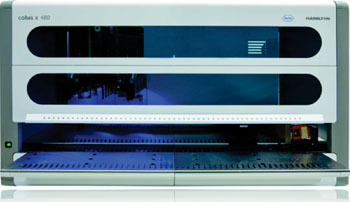HPV Test Approved for Primary Screening of Cervical Cancer
|
By LabMedica International staff writers Posted on 05 May 2014 |

Image: The cobas 4800 Detection System (Photo courtesy of Roche Molecular Systems).
A newly approved molecular test offers women an alternative option for cervical cancer screening and this most recent approval means the test can now be used as the first port of call for cervical cancer screening for women aged 25 years and over. To date, the two main techniques used for cervical cancer screening were liquid-based cytology, and the most common form of cervical cancer screening, the Papanicolaou (Pap) test, also referred to as a cervical smear test.
The US Food and Drug Administration (FDA; Silver Spring, MD, USA) have approved the first human papillomavirus (HPV) DNA test for primary cervical cancer screening. The cobas human papillomavirus (HPV) test can detect 14 types of HPV that present high risk of cervical cancer. Specifically, the test identifies HPV 16 and HPV 18, the two types that are responsible for around 70% of cervical cancer cases.
If the test detects HPV 16 or HPV 18, a patient will be required to undergo a colposcopy, where a device is inserted into the cervix and illuminates and magnifies the area, allowing direct observation of cervical cells. If the cobas HPV test, which was developed by Roche Molecular Systems (Pleasanton, CA, USA) detects any of the other 12 high-risk HPV types, patients will then be required to have a Pap test, which will determine whether they need a colposcopy.
A study conducted by Roche involving more than 40,000 women, has shown that the cobas HPV test is safe and effective. The women in study were aged at least 25 years and underwent a cobas HPV test and a Pap test. Women whose cervical cells screened positive for HPV using the cobas HPV test or who had a positive Pap test, as well as women who had negative Pap and HPV tests, had a colposcopy and cervical tissue biopsy. Biopsy results were compared with both the cobas HPV test results and the Pap test results. The study found that the cobas HPV test could accurately identify HPV 16 and HPV 18 in women, therefore predicting a woman's risk for cervical cancer.
Alberto Gutierrez, PhD, of the FDA's Center for Devices and Radiological Health, said, “This approval offers women and physicians a new option for cervical cancer screening. Roche Diagnostics conducted a well-designed study that provided the FDA with a reasonable assurance of the safety and effectiveness when used as a primary screening tool for cervical cancer.”
Related Links:
US Food and Drug Administration
Roche Molecular Systems
The US Food and Drug Administration (FDA; Silver Spring, MD, USA) have approved the first human papillomavirus (HPV) DNA test for primary cervical cancer screening. The cobas human papillomavirus (HPV) test can detect 14 types of HPV that present high risk of cervical cancer. Specifically, the test identifies HPV 16 and HPV 18, the two types that are responsible for around 70% of cervical cancer cases.
If the test detects HPV 16 or HPV 18, a patient will be required to undergo a colposcopy, where a device is inserted into the cervix and illuminates and magnifies the area, allowing direct observation of cervical cells. If the cobas HPV test, which was developed by Roche Molecular Systems (Pleasanton, CA, USA) detects any of the other 12 high-risk HPV types, patients will then be required to have a Pap test, which will determine whether they need a colposcopy.
A study conducted by Roche involving more than 40,000 women, has shown that the cobas HPV test is safe and effective. The women in study were aged at least 25 years and underwent a cobas HPV test and a Pap test. Women whose cervical cells screened positive for HPV using the cobas HPV test or who had a positive Pap test, as well as women who had negative Pap and HPV tests, had a colposcopy and cervical tissue biopsy. Biopsy results were compared with both the cobas HPV test results and the Pap test results. The study found that the cobas HPV test could accurately identify HPV 16 and HPV 18 in women, therefore predicting a woman's risk for cervical cancer.
Alberto Gutierrez, PhD, of the FDA's Center for Devices and Radiological Health, said, “This approval offers women and physicians a new option for cervical cancer screening. Roche Diagnostics conducted a well-designed study that provided the FDA with a reasonable assurance of the safety and effectiveness when used as a primary screening tool for cervical cancer.”
Related Links:
US Food and Drug Administration
Roche Molecular Systems
Latest Pathology News
- Sensitive and Specific DUB Enzyme Assay Kits Require Minimal Setup Without Substrate Preparation
- World’s First AI Model for Thyroid Cancer Diagnosis Achieves Over 90% Accuracy
- Breakthrough Diagnostic Approach to Significantly Improve TB Detection
- Rapid, Ultra-Sensitive, PCR-Free Detection Method Makes Genetic Analysis More Accessible
- Spit Test More Accurate at Identifying Future Prostate Cancer Risk
- DNA Nanotechnology Boosts Sensitivity of Test Strips
- Novel UV and Machine Learning-Aided Method Detects Microbial Contamination in Cell Cultures
- New Error-Corrected Method to Help Detect Cancer from Blood Samples Alone
- "Metal Detector" Algorithm Hunts Down Vulnerable Tumors
- Novel Technique Uses ‘Sugar’ Signatures to Identify and Classify Pancreatic Cancer Cell Subtypes
- Advanced Imaging Reveals Mechanisms Causing Autoimmune Disease
- AI Model Effectively Predicts Patient Outcomes in Common Lung Cancer Type
- AI Model Predicts Patient Response to Bladder Cancer Treatment
- New Laser-Based Method to Accelerate Cancer Diagnosis
- New AI Model Predicts Gene Variants’ Effects on Specific Diseases
- Powerful AI Tool Diagnoses Coeliac Disease from Biopsy Images with Over 97% Accuracy
Channels
Clinical Chemistry
view channel
‘Brilliantly Luminous’ Nanoscale Chemical Tool to Improve Disease Detection
Thousands of commercially available glowing molecules known as fluorophores are commonly used in medical imaging, disease detection, biomarker tagging, and chemical analysis. They are also integral in... Read more
Low-Cost Portable Screening Test to Transform Kidney Disease Detection
Millions of individuals suffer from kidney disease, which often remains undiagnosed until it has reached a critical stage. This silent epidemic not only diminishes the quality of life for those affected... Read more
New Method Uses Pulsed Infrared Light to Find Cancer's 'Fingerprints' In Blood Plasma
Cancer diagnoses have traditionally relied on invasive or time-consuming procedures like tissue biopsies. Now, new research published in ACS Central Science introduces a method that utilizes pulsed infrared... Read moreMolecular Diagnostics
view channel
New Blood Test Detects 12 Common Cancers Before Symptoms Appear
Bowel cancer is the fourth most common cancer in the UK, with over 42,000 new diagnoses each year. Detecting bowel cancer in its early stages can be challenging, and as the disease progresses, survival... Read more
Blood Test Could Predict Relapse of Autoimmune Blood Vessel Disease
Neutrophils, once believed to be uniform in nature, have been discovered to exhibit significant diversity. These immune cells, which play a crucial role in fighting infections, are also implicated in autoimmune... Read moreHematology
view channel
New Scoring System Predicts Risk of Developing Cancer from Common Blood Disorder
Clonal cytopenia of undetermined significance (CCUS) is a blood disorder commonly found in older adults, characterized by mutations in blood cells and a low blood count, but without any obvious cause or... Read more
Non-Invasive Prenatal Test for Fetal RhD Status Demonstrates 100% Accuracy
In the United States, approximately 15% of pregnant individuals are RhD-negative. However, in about 40% of these cases, the fetus is also RhD-negative, making the administration of RhoGAM unnecessary.... Read moreImmunology
view channel
Stem Cell Test Predicts Treatment Outcome for Patients with Platinum-Resistant Ovarian Cancer
Epithelial ovarian cancer frequently responds to chemotherapy initially, but eventually, the tumor develops resistance to the therapy, leading to regrowth. This resistance is partially due to the activation... Read more
Machine Learning-Enabled Blood Test Predicts Immunotherapy Response in Lymphoma Patients
Chimeric antigen receptor (CAR) T-cell therapy has emerged as one of the most promising recent developments in the treatment of blood cancers. However, over half of non-Hodgkin lymphoma (NHL) patients... Read moreMicrobiology
view channel
Handheld Device Delivers Low-Cost TB Results in Less Than One Hour
Tuberculosis (TB) remains the deadliest infectious disease globally, affecting an estimated 10 million people annually. In 2021, about 4.2 million TB cases went undiagnosed or unreported, mainly due to... Read more
New AI-Based Method Improves Diagnosis of Drug-Resistant Infections
Drug-resistant infections, particularly those caused by deadly bacteria like tuberculosis and staphylococcus, are rapidly emerging as a global health emergency. These infections are more difficult to treat,... Read more
Breakthrough Diagnostic Technology Identifies Bacterial Infections with Almost 100% Accuracy within Three Hours
Rapid and precise identification of pathogenic microbes in patient samples is essential for the effective treatment of acute infectious diseases, such as sepsis. The fluorescence in situ hybridization... Read moreTechnology
view channel
Disposable Microchip Technology Could Selectively Detect HIV in Whole Blood Samples
As of the end of 2023, approximately 40 million people globally were living with HIV, and around 630,000 individuals died from AIDS-related illnesses that same year. Despite a substantial decline in deaths... Read more
Pain-On-A-Chip Microfluidic Device Determines Types of Chronic Pain from Blood Samples
Chronic pain is a widespread condition that remains difficult to manage, and existing clinical methods for its treatment rely largely on self-reporting, which can be subjective and especially problematic... Read more
Innovative, Label-Free Ratiometric Fluorosensor Enables More Sensitive Viral RNA Detection
Viruses present a major global health risk, as demonstrated by recent pandemics, making early detection and identification essential for preventing new outbreaks. While traditional detection methods are... Read moreIndustry
view channel
Cepheid and Oxford Nanopore Technologies Partner on Advancing Automated Sequencing-Based Solutions
Cepheid (Sunnyvale, CA, USA), a leading molecular diagnostics company, and Oxford Nanopore Technologies (Oxford, UK), the company behind a new generation of sequencing-based molecular analysis technologies,... Read more
Grifols and Tecan’s IBL Collaborate on Advanced Biomarker Panels
Grifols (Barcelona, Spain), one of the world’s leading producers of plasma-derived medicines and innovative diagnostic solutions, is expanding its offer in clinical diagnostics through a strategic partnership... Read more







 Assay.jpg)













